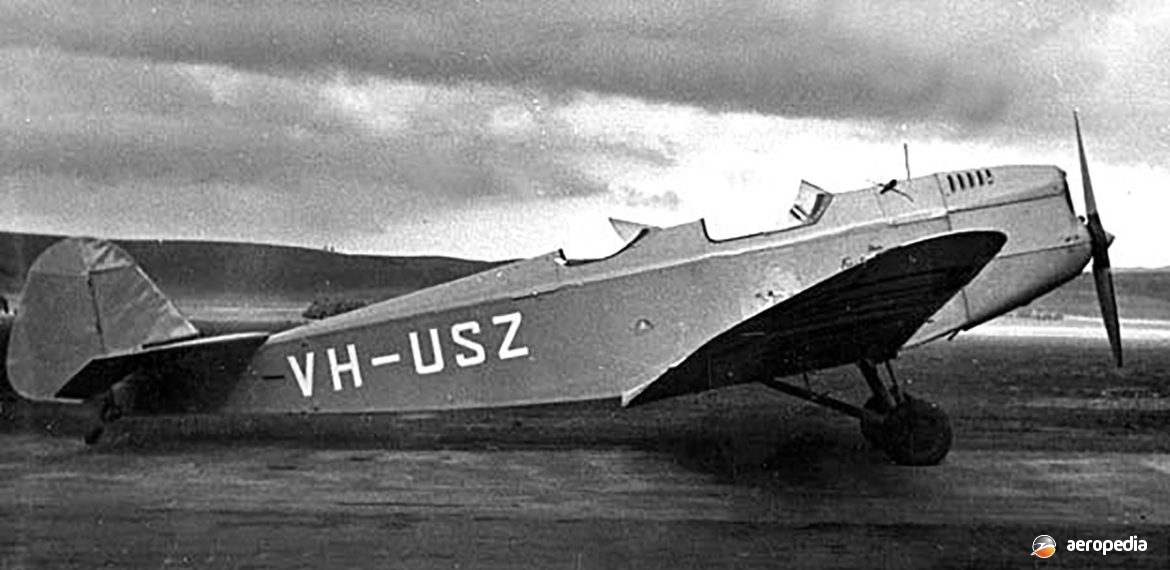Photograph:
Klemm L.27a VH-USZ (c/n 330) in 1936 (Eddie Coates Collection)
Country of origin:
Germany
Description:
Two/three-seat light aircraft
Power Plant:
One 75 kw (100 hp) Argus As.8 four-cylinder inverted in-line air-cooled engine
Specifications:
- Wingspan: 13 m (42 ft 7½ in)
- Length: 7.5 m (24 ft 7½ in
- Height: 2.10 m (6 ft 11 in)
- Wing area: 20 m² (215 sq ft)
- Max speed: 175 km/h (109 mph)
- Landing speed: 62 km/h (38 mph)
- Climb to 1,000 m (3,280 ft): 4 mins
- Ceiling: 6,000 m (19,680 ft)
- Empty weight: 400 kg (882 lb)
- Disposable load: 450 kg (990 lb)
- Loaded weight: 700 kg (1,544 lb)
History:
Leichtflugzeugbau Klemm Gmbh of Boeblingen, Wuertemberg, was the successor to the Daimler-Werke AG which first produced light aircraft in 1919. The new company, founded in 1927, produced a range of light aircraft in the 1930s and licence construction of some of the Company’s products was granted to British Klemm Aeroplane Company Ltd of Hanworth Air Park, London.
The L.27 was a development of the L.25 series, this being a lengthened and strengthened variant of the L.26a with an enlarged cockpit; and later again it was developed to the L.28 series. The Klemm series of light aircraft was designed by Dr Ing Hans Klemm, who originally designed light aircraft for Daimler Aircraft Co of Stuttgart, commencing in 1919.
Three examples were registered in the United Kingdom, the first, an L.27a (G-ABJX) with a 71 kw (95 hp) ADC Cirrus II engine; the second, an L.27a VIII (G-ABOP) with a 78 kw (105 hp) Cirrus Hermes IIB engine; and the third, an L.27aIX (G-ABOR) with a 90 kw (120 hp) de Havilland Gipsy III engine, this latter machine later being imported to Australia.
This aircraft (VH-USZ – c/n 330) was previously owned by Air Work Ltd (as G-ABOR) from August 1931. It was then obtained by Mr G Gropler of Norwood SA, father of Roy Gropler. Roy received his A-licence at the Royal Aero Club of South Australia in June 1934 and, with 60 hours flying time, he left Australia and arrived in the United Kingdom in November 1935 where he purchased the second-hand Klemm G-ABOR.
On 10 December 1935, in the middle of winter, after having extra fuel tanks installed, he left London to fly to Australia but because of the Italian invasion of Ethiopia had to change his route. He flew to Belgium and arrived in Brussels and over the following days flew along the Rhine River to Austria, weather conditions being bad. He then followed the Danube River but landed in Czechoslovakia and was detained as a spy. After release he flew to Budapest and on to Athens where he ran into a blizzard and spent Christmas there.
He flew to Aleppo where the propeller was damaged and he had to await delivery of a new propeller from Cairo. He celebrated his 20th birthday in Baghdad and then continued on to Jask in Persia, Karachi, Hyderabad and Jodhpur. He continued on via Allahabad, Calcutta, Rangoon, Victoria Point, Alor Star, Singapore, Batavia, Surabaya, Rambang and Koepang. In Darwin he was greeted by a small crowd.
The flight continued on by following the telegraph line to Alice Springs and then the railway line to Adelaide where he arrived on 22 January 1936, the trip having taken 43 days.
In Australia the Klemm became VH-USZ in June that year, being registered to Mr Gropler’s father as he had provided the capital for the trip. At that stage it was fitted with a 90 kw (120 hp) de Havilland Gipsy Mk II engine and was issued with its Certificate of Airworthiness (No 553) on 17 June 1936. The Klemm was subsequently used for joy flights from Parafield, SA with occasional flights to country towns for aerial photography. In December 1936 Mr Gropler took part in the Brisbane to Adelaide Air Race to celebrate the Centenary of South Australia, winning third place in the handicap race.
In January 1938 Roy Gropler flew non-stop from Adelaide to Sydney in a time of 7 hours 45 mins where further joy-flights were carried out before a non-stop flight of 11 hours was made back to Adelaide. On 13 March 1937 Roy Gropler and his two passengers were killed during a joy-flight from Parafield when the port-wing departed the aircraft near Salisbury, SA in a steep turn and it crashed.

